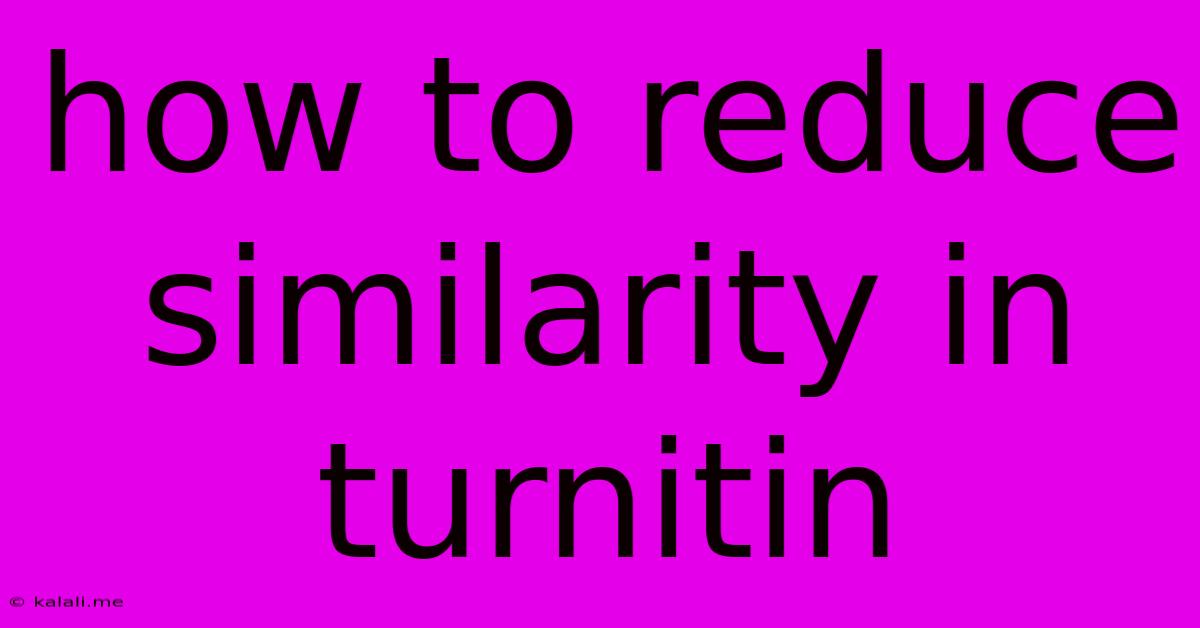How To Reduce Similarity In Turnitin
Kalali
May 22, 2025 · 3 min read

Table of Contents
How to Reduce Similarity in Turnitin: A Comprehensive Guide
Turnitin, a popular plagiarism detection software, is used by many educational institutions and businesses to check for originality. A high similarity score can be concerning, but it doesn't necessarily mean plagiarism. This article will guide you through effective strategies to reduce your Turnitin similarity score while maintaining the integrity of your work. Understanding how Turnitin works and implementing these techniques will help you submit original, high-quality content.
Understanding Turnitin's Similarity Score
Turnitin compares your submitted work against a vast database of academic papers, websites, and published content. The similarity score represents the percentage of your text that matches existing sources. A high score doesn't automatically equate to plagiarism; it simply indicates areas where your writing overlaps with other materials. These overlaps can be due to:
- Direct quotes: Failure to properly cite direct quotes.
- Paraphrasing errors: Incorrect or insufficient paraphrasing.
- Common phrases and terminology: The use of standard phrases or terminology within a field.
- Self-plagiarism: Reusing your own previously submitted work.
Strategies to Reduce Turnitin Similarity
Here are actionable steps to lower your Turnitin similarity score legitimately:
1. Master the Art of Paraphrasing
Paraphrasing is crucial. Don't just replace a few words; rewrite the entire sentence in your own words, maintaining the original meaning. Focus on understanding the core concept and expressing it using different sentence structures and vocabulary.
- Use synonyms: Replace words with their synonyms, but ensure the meaning remains unchanged.
- Change sentence structure: Transform active voice to passive voice or vice-versa.
- Summarize information: Condense lengthy paragraphs into concise summaries.
2. Proper Citation and Referencing
Accurate citation is paramount. Always cite sources using a consistent style guide (e.g., MLA, APA, Chicago). Properly cite direct quotes, paraphrased information, and any borrowed ideas. Using a citation management tool can help maintain accuracy and consistency.
- Direct Quotes: Enclose direct quotes in quotation marks and cite the source immediately.
- Paraphrased Material: Clearly indicate paraphrased information with in-text citations.
- Bibliographies: Include a complete bibliography or works cited page listing all referenced sources.
3. Original Thought and Analysis
Focus on presenting your original analysis and interpretation of the source material. Don't simply summarize; add your unique perspective, critical evaluation, and insights. This demonstrates your understanding and strengthens the originality of your work.
4. Effective Use of Quotation Marks
Over-reliance on quotes can inflate your similarity score. Use quotes sparingly, only when the original wording is essential and cannot be effectively paraphrased. Always properly attribute the quote.
5. Break Up Large Blocks of Text
Long, uninterrupted paragraphs can lead to higher similarity scores. Break your text into shorter, more manageable paragraphs to improve readability and reduce the likelihood of matching existing sources. This enhances the flow and clarity of your writing.
6. Proofread and Edit Carefully
A thorough review is vital. Carefully check for unintentional plagiarism and ensure all citations are accurate and complete. Use grammar and plagiarism checkers to identify any potential issues.
7. Use Multiple Sources
Relying on a limited number of sources can increase similarity. Expand your research to include a wider range of materials, enabling a more comprehensive and original perspective. This enriches your understanding and allows for a more diverse range of cited sources.
8. Seek Feedback
Before submission, ask a peer or mentor to review your work. A fresh perspective can help identify areas that need improvement and potential plagiarism issues.
Conclusion:
Reducing your Turnitin similarity score is achievable through diligent research, careful writing, and proper citation. By understanding Turnitin's mechanics and implementing these strategies, you can ensure your work reflects your original thinking and avoids unintentional plagiarism. Remember, the goal isn't to manipulate the system, but to produce high-quality, original academic work.
Latest Posts
Latest Posts
-
Why Do I Get Electric Shock When I Touch Someone
May 22, 2025
-
Cement Lime Sand Mortar Mix Ratio
May 22, 2025
-
Sync Outlook Contacts With Android Contacts
May 22, 2025
-
How Do You Get Sticky Residue Off Wood
May 22, 2025
-
How Do You Reset Airbag Light
May 22, 2025
Related Post
Thank you for visiting our website which covers about How To Reduce Similarity In Turnitin . We hope the information provided has been useful to you. Feel free to contact us if you have any questions or need further assistance. See you next time and don't miss to bookmark.